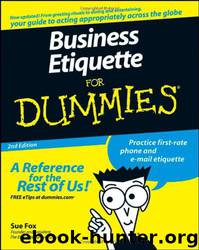Business Etiquette for Dummies by Sue Fox

Author:Sue Fox [Fox, Sue]
Language: eng
Format: epub
Tags: Business & Economics, Business Etiquette
ISBN: 9780470147092
Google: yvVPTD4Cv84C
Amazon: 0470147091
Publisher: For Dummies
Published: 2008-04-28T00:00:00+00:00
18_147092-ch12.qxp 3/27/08 9:19 AM Page 167
Chapter 12: Mastering Dining Etiquette
167
The host may offer a toast before the meal. The toast should be simple and short. Something like “Here’s to dining with esteemed colleagues” is fine.
A Primer on Basic and
Formal Table Settings
The first step in intelligent utensil use is learning where the basic utensils and dishes go on a dining table and how to use them. Then you’ll be ready for advanced utensil information — those additional utensils and china you may encounter in formal dining. At every meal, you have a plate, a napkin, several utensils — usually consisting of a knife, fork, and soup spoon — and at least one glass. Sometimes, you have a bread-and-butter plate. When you add a salad fork, you’ve filled out the simple place setting that most Americans recognize. Sometimes, a salad plate rests on the table rather than being delivered with the salad, and the dessert utensils, dessert plate, and coffee or teacups and their spoons may appear after the meal. See Figure 12-1 for an illustration of a basic table setting.
The basic setting is an abbreviated version of a full or formal place setting, which can have any number of other utensils, plates, and glasses.
Figure 12-1:
An
American
basic table
setting.
18_147092-ch12.qxp 3/27/08 9:19 AM Page 168
168 Part III: Behaving in the Boardroom and Beyond The most important rules to learn in dining, whether casual or formal, are ߜ Drinks right, bread plate left. (Another version is liquids to the right, solids to the left.)
ߜ Fork is a four-letter word, as is the word “left.” Knife is a five-letter word, as is the word “right.”
ߜ Start by using the utensils placed farthest from the plate and work inward with each course. By examining the formal place setting in Figure 12-2, you get a good idea of what each course will be.
Plates
The place plate, or main dinner plate, is in the center in front of each chair setting. In formal dining, you usually find a charger (underplate) as well. The bread plate is always to the left, slightly above the forks, with a small knife across the top. That knife is the butter spreader. If soup is served as a first course, the soup bowl will be on a service plate. A salad, if served as a first course, may be placed on the service plate, and the salad plate will then be removed. The charger or underplate is removed from the table before the dessert is served.
Toward the end of the meal, you may find a small plate with a doily and a small bowl above your dinner plate. These items are the dessert plate and finger bowl, respectively. A small fork and spoon — your dessert spoon and fork — will be resting on the edge of the dessert plate.
Utensils
Forks are to the left of the plate, and knives and spoons go to the right (with the exception of the tiny cocktail fork, which is placed on the soup spoon or to the right of the soup spoon).
Download
This site does not store any files on its server. We only index and link to content provided by other sites. Please contact the content providers to delete copyright contents if any and email us, we'll remove relevant links or contents immediately.
Tools of Titans by Timothy Ferriss(8304)
Change Your Questions, Change Your Life by Marilee Adams(7684)
Deep Work by Cal Newport(6966)
Playing to Win_ How Strategy Really Works by A.G. Lafley & Roger L. Martin(6082)
Man-made Catastrophes and Risk Information Concealment by Dmitry Chernov & Didier Sornette(5956)
Digital Minimalism by Cal Newport;(5704)
Big Magic: Creative Living Beyond Fear by Elizabeth Gilbert(5676)
The Slight Edge by Jeff Olson(5376)
Ego Is the Enemy by Ryan Holiday(5347)
The Motivation Myth by Jeff Haden(5175)
The Laws of Human Nature by Robert Greene(5080)
Stone's Rules by Roger Stone(5051)
Tuesdays with Morrie by Mitch Albom(4729)
Eat That Frog! by Brian Tracy(4483)
Rising Strong by Brene Brown(4411)
Skin in the Game by Nassim Nicholas Taleb(4201)
Bullshit Jobs by David Graeber(4138)
The Money Culture by Michael Lewis(4132)
Skin in the Game: Hidden Asymmetries in Daily Life by Nassim Nicholas Taleb(3960)
